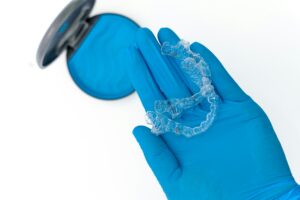Many people assume that orthodontic treatment is only for teenagers and young adults. But Invisalign for seniors is a real option for those looking to improve their smile later in life. Clear aligners offer a modern alternative to braces, making it easier to correct misaligned teeth without noticeable wires or brackets.
Teeth continue to shift over time, even in adulthood. Some seniors experience crowding, gaps, or bite issues that can affect both appearance and oral health. Invisalign provides a solution that is comfortable, removable, and effective for many older adults. If you’ve been considering straightening your teeth but thought it was too late, now is the time to explore your options.
Is Invisalign Effective for Seniors?
How Invisalign Works at Any Age

Invisalign gradually shifts teeth using a series of custom-made, clear plastic aligners. Unlike traditional braces, these aligners are removable and nearly invisible. The process involves wearing each set of aligners for about two weeks before switching to the next. Over time, teeth move into better alignment.
Age does not prevent someone from using Invisalign. While younger patients may experience slightly faster results due to bone density, seniors can still achieve excellent outcomes. The key is consistency—wearing aligners as instructed and following professional guidance.
Factors That Can Affect Treatment for Seniors
Before starting Invisalign, it’s important to consider certain factors that may impact the process:
- Bone Density – As people age, bone density naturally decreases. This can affect how quickly teeth shift but does not stop movement entirely. A consultation with an orthodontist can determine if treatment is appropriate.
- Existing Dental Work – Many seniors have crowns, bridges, or implants. Invisalign can often work around these, but an orthodontist will assess how the aligners interact with existing restorations.
- Gum Health – Healthy gums are essential for successful treatment. Gum disease or significant recession can affect alignment and should be addressed before starting Invisalign.
Invisalign for seniors is designed to be flexible and accommodate different dental needs. With proper evaluation and a customized plan, many older adults achieve straighter teeth and improved oral health.
Benefits of Invisalign for Seniors
Comfort and Convenience
Traditional braces can be uncomfortable, especially for those who prefer a low-maintenance solution. Invisalign aligners are smooth, custom-made, and fit snugly over teeth without metal wires or brackets. This reduces irritation to the gums and cheeks.
Another major advantage is that Invisalign aligners are removable. Seniors can take them out when eating, drinking anything other than water, and brushing their teeth. This makes daily routines easier and allows for better oral hygiene compared to traditional braces, which can trap food and bacteria.
Improved Oral Health
Crooked or misaligned teeth can lead to oral health problems, including gum disease, cavities, and uneven wear on teeth. Straightening teeth with Invisalign can help prevent these issues by making them easier to clean. Proper alignment also reduces strain on the jaw, which may decrease discomfort or headaches caused by bite issues.
For seniors concerned about long-term dental health, Invisalign can be a valuable investment. Aligned teeth support better gum health, lower the risk of decay, and contribute to an overall healthier smile.
Aesthetic Confidence
Feeling good about your smile is important at any age. Invisalign aligners are nearly invisible, allowing seniors to straighten their teeth without noticeable hardware. Many adults and older patients appreciate the ability to improve their appearance discreetly.
A straighter smile can also boost confidence in social and professional settings. Some seniors choose Invisalign not only for oral health benefits but also for the self-assurance that comes with having well-aligned teeth.
What to Expect During Treatment
Initial Consultation and Assessment
The first step in getting Invisalign for seniors is scheduling a consultation with a qualified orthodontist or dentist. During this visit, the provider will assess overall oral health, discuss alignment goals, and determine if Invisalign is a good option.
A digital scan or impressions of the teeth will be taken to create custom aligners. The provider will also check for any existing dental issues, such as gum disease or cavities, that may need treatment before starting Invisalign.
Wearing and Caring for Aligners
For the best results, aligners must be worn 20 to 22 hours per day. They should only be removed when eating, drinking anything other than water, or cleaning teeth. Consistency is key to keeping treatment on track.
To maintain hygiene and prevent staining, aligners should be:
- Rinsed with lukewarm water after removal.
- Cleaned with a soft toothbrush and mild soap (avoid toothpaste, as it can be too abrasive).
- Stored in their protective case when not in use.
Proper care ensures that aligners remain clear and free from bacteria buildup.
Average Treatment Time for Seniors
The length of Invisalign treatment varies based on the complexity of tooth movement. On average, treatment lasts 12 to 18 months, though some cases may take less time.
Factors that can influence treatment duration include:
- Severity of misalignment – Minor adjustments take less time, while more complex cases may require longer treatment.
- Bone density and tooth movement speed – Older adults may experience slightly slower shifts compared to younger patients, but progress remains steady with proper aligner wear.
- Compliance with wearing aligners – The more consistently aligners are worn, the faster and more effective the treatment.
Invisalign for seniors follows the same general timeline as it does for younger adults, making it a practical choice for those looking for a comfortable and discreet way to straighten their teeth.
Common Concerns About Invisalign for Seniors
Is It Too Late to Straighten My Teeth?
Many seniors wonder if Invisalign will still be effective at their age. The answer is yes—teeth can move at any stage of life. While younger patients may experience slightly faster results due to higher bone density, seniors can still achieve excellent alignment with consistent wear. Orthodontists consider overall dental health more important than age when determining if Invisalign is a good fit.
Will It Be Uncomfortable?
Some people worry about discomfort when starting Invisalign. Like any orthodontic treatment, there may be mild pressure when switching to a new set of aligners. However, this sensation usually fades within a few days. Unlike metal braces, Invisalign does not have sharp brackets or wires that can cause irritation. Most patients find aligners more comfortable and easier to adjust to over time.
Can I Afford Invisalign?
Cost is another common concern. Invisalign pricing depends on the complexity of treatment, but many providers offer flexible payment plans to make it more affordable. Some dental insurance plans provide partial coverage for Invisalign, similar to traditional braces.
For seniors on a budget, it’s worth asking about financing options, insurance benefits, and potential discounts for upfront payments. Many orthodontists provide free consultations to go over costs and payment plans before committing to treatment.
Getting Started with Invisalign for Seniors
Finding the Right Provider
Choosing an experienced Invisalign provider is essential for a smooth and successful treatment process. Not all dentists or orthodontists specialize in Invisalign for seniors, so it’s important to find one who understands the unique needs of older patients.
When selecting a provider, consider asking:
- How many Invisalign cases have they treated in older adults?
- What challenges might arise due to existing dental work?
- Are there payment plans or financing options available?
A thorough consultation will help determine if Invisalign is the right choice and what adjustments, if any, are needed for individual dental conditions.
Preparing for Treatment
Before starting Invisalign, a full dental checkup is recommended. Any untreated cavities, gum disease, or other dental issues should be addressed beforehand to avoid complications during treatment.
Patients should also be prepared for:
- Wearing aligners 20 to 22 hours per day for effective results.
- Cleaning aligners regularly to maintain hygiene and avoid staining.
- Attending regular checkups to monitor progress and receive new aligners.
Final Thoughts
Invisalign for seniors is a practical solution for those who want to improve their smile without traditional braces. With the right provider and commitment to treatment, older adults can enjoy the benefits of straighter teeth, better oral health, and increased confidence. It’s never too late to take steps toward a healthier, more aligned smile.
Start Your Invisalign Journey with Carroll Orthodontics
Invisalign for seniors is a comfortable and effective way to achieve a straighter smile at any age. If you’ve been considering clear aligners, now is the time to explore your options with a trusted expert.
At Carroll Orthodontics, Dr. Marshall Carroll provides personalized Invisalign treatment designed to fit your lifestyle. As a leading orthodontist, he combines years of experience with advanced technology to ensure the best possible results. No referrals are required, and we offer a complimentary evaluation to help you understand your treatment options.
Take the first step toward a healthier, more confident smile. Schedule your free consultation with Carroll Orthodontics today.

